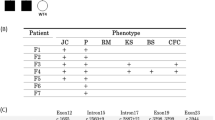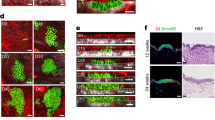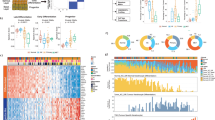Abstract
Basal-cell carcinomas (BCCs) are the commonest human cancer1. Insight into their genesis came from identification of mutations in the PATCHED gene (PTCH) in patients with the basal-cell nevus syndrome, a hereditary disease characterized by multiple BCCs and by developmental abnormalities2,3,4,5,6,7. The binding of Sonic hedgehog (SHH) to its receptor, PTCH, is thought to prevent normal inhibition by PTCH of Smoothened (SMO), a seven-span transmembrane protein8,9. According to this model, the inhibition of SMO signalling is relieved following mutational inactivation of PTCH in basal-cell nevus syndrome. We report here the identification of activating somatic missense mutations in the SMO gene itself in sporadic BCCs from three patients. Mutant SMO, unlike wild type, can cooperate with adenovirus E1A to transform rat embryonic fibroblast cells in culture. Furthermore, skin abnormalities similar to BCCs developed in transgenic murine skin overexpressing mutant SMO. These findings support the role of SMO as a signalling component of the SHH–receptor complex and provide direct evidence that mutated SMO can function as an oncogene in BCCs.
This is a preview of subscription content, access via your institution
Access options
Subscribe to this journal
Receive 51 print issues and online access
$199.00 per year
only $3.90 per issue
Buy this article
- Purchase on SpringerLink
- Instant access to full article PDF
Prices may be subject to local taxes which are calculated during checkout




Similar content being viewed by others
References
Miller, D. L. & Weinstock, M. A. Nonmelanoma skin cancer in the United States: incidence. J. Am. Acad. Dermatol. 30, 774–778 (1994).
Hahn, H. et al. Mutations of the human homolog of Drosophila patched in the nevoid basal cell carcinoma syndrome. Cell 85, 841–851 (1996).
Johnson, R. L. et al. Human homolog of patched, a candidate gene for the basal cell nevus syndrome. Science 272, 1668–1671 (1996).
Chidambaram, A. et al. Mutations in the human homologue of the Drosophila patched gene in Caucasian and African–American nevoid basal cell carcinoma syndrome patients. Cancer Res. 56, 4599–4601 (1996).
Unden, A. B. et al. Mutations in the human homologue of Drosophila patched (PTCH) in basal cell carcinomas and the Grolin syndrom: different in vivo mechanisms of PTCH inactivation. Cancer Res. 56, 4562–4565 (1996).
Gailani, M. R. et al. The role of the human homologue of Drosophila patched in sporadic basal cell carcinomas. Nature Genet. 14, 78–81 (1996).
Wicking, C. et al. Most germ-line mutations in the nevoid basal cell carcinoma syndrom lead to a premature termination of the PATCHED protein, and no genotype–phenotype correlations are evident. Am. J. Hum. Genet. 60, 21–26 (1997).
Stone, D. M. et al. The tumour-suppressor gene patched encodes a candidate receptor for Sonic hedgehog. Nature 384, 129–134 (1996).
Marigo, V., Davey, R. A., Zuo, Y., Cunningham, J. M. & Tabin, C. J. Biochemical evidence that patched is the Hedgehog receptor. Nature 384, 176–179 (1996).
Raffel, C. et al. Sporadic medulloblastomas contain PTCH mutations. Cancer Res. 57, 842–845 (1997).
Xie, J. et al. Mutations of the PATCHED gene in several types of sporadic extracutaneous tumors. Cancer Res. 57, 2369–2372 (1997).
Oro, A. E. et al. Basal cell carcinomas in mice overexpressing Sonic hedgehog. Science 276, 817–821 (1997).
Fan, H., Oro, A. E., Scott, M. P. & Khavary, P. A. Induction of features of basal cell epithelioma in transgenic human skin expressing sonic hedgehog in vivo. J. Invest. Dermatol. 108, 544 (1997).
Scheer, A., Fanelli, F., Costa, T., De Benedetti, P. G. & Cotecchia, S. The activation process of the alpha 1B-adrenergic receptor: potential role of protonation and hydrophobicity of a highly conserved aspartate. Proc. Natl Acad. Sci. USA 94, 808–813 (1997).
Kinzler, K. W. et al. Identification of an amplified, highly expressed gene in a human glioma. Science 236, 70–73 (1987).
Ruppert, J. M., Vogelstein, B. & Kinzler, K. W. The zinc finger protein GLI transforms primary cells in cooperation with adenovirus E1A. Mol. Cell. Biol. 11, 1724–1728 (1991).
Heid, C. A., Stevens, J., Livak, K. J. & Williams, P. M. Real time quantitative PCR. Genome Res. 6, 986–994 (1996).
Byme, C. & Fuchs, E. Probing keratinocyte and differentiation specificity of the human K5 promoter in vitro and in transgenic mice. Mol. Cell. Biol. 13, 3176–3190 (1993).
Unden, A. B., Kerstin, B., Zaphiropulos, P. G., Toftgard, R. & Backdal, M. S. The gene for Gorlin's syndrome, human patched, is consistently overexpressed in both hereditary and sporadic basal cell carcinomas. J. Invest. Dermatol. 108, 596 (1997).
Wigler, M. et al. DNA-mediated transfer of the adenine phosphoribosyltransferase locus into mammalian cells. Proc. Natl Acad. Sci. USA 76, 1373–1376 (1979).
Zhu, J., Rice, P. W., Gorsch, L., Abate, M. & Cole, C. N. Transformation of a continuous rat embryo fibroblast cell line requires three separate domains of simian virus 40 large T antigen. J. Virol. 66, 2780–2791 (1992).
Acknowledgements
We thank D. Sherman and V. Bhagwandin for technical help, J. Ramirez for histology, K. Hagler for immunohistochemistry, E. Nelson for help with the animals, the Genentech DNA synthesis group, C. Hoffman and W. Anstine for preparing the figures, E. Fuchs for the K5 promoter, J.Gitscher for facilitating our collaboration and F. McCormick and M. Scott for advice and discussions. J.X. was the recipient of a Neutrogena fellowship of the Dermatology Foundation. Research in San Francisco was supported by the National Institute of Arthritis, Musculoskeletal and Skin Diseases.
Author information
Authors and Affiliations
Corresponding authors
Supplementary Information
Rights and permissions
About this article
Cite this article
Xie, J., Murone, M., Luoh, SM. et al. Activating Smoothened mutations in sporadic basal-cell carcinoma. Nature 391, 90–92 (1998). https://doi.org/10.1038/34201
Received:
Accepted:
Published:
Issue Date:
DOI: https://doi.org/10.1038/34201



